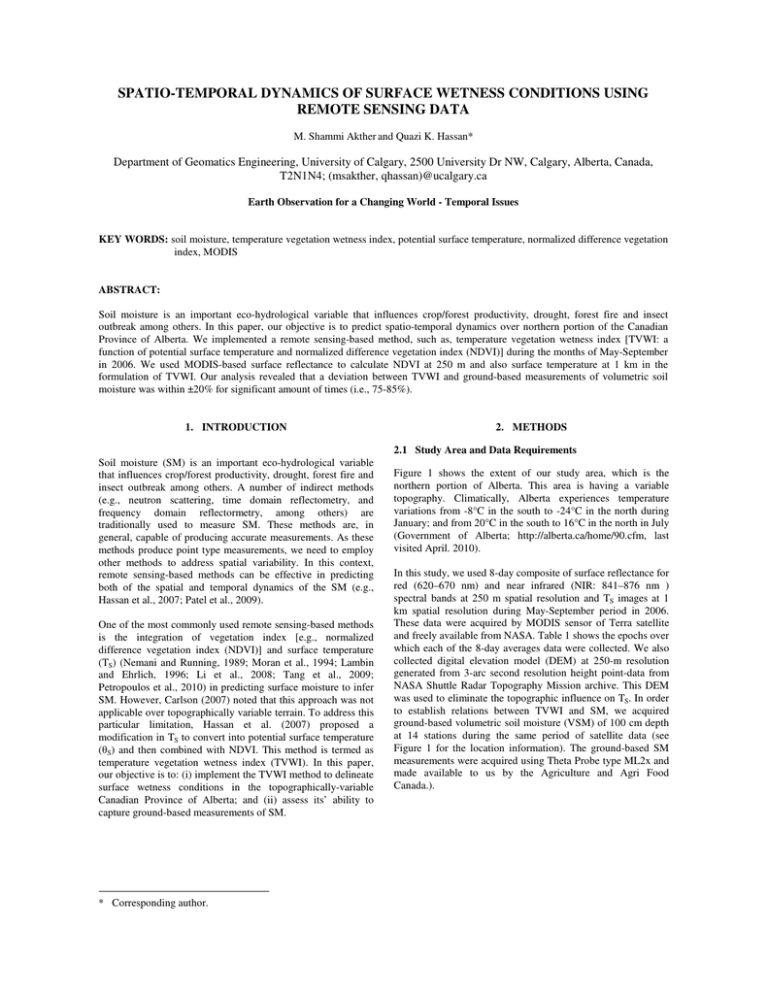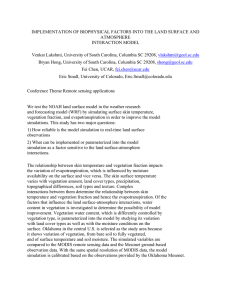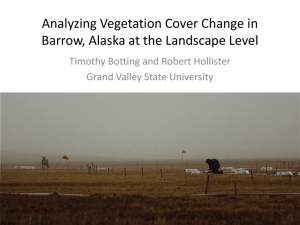SPATIO-TEMPORAL DYNAMICS OF SURFACE WETNESS CONDITIONS USING REMOTE SENSING DATA
advertisement

SPATIO-TEMPORAL DYNAMICS OF SURFACE WETNESS CONDITIONS USING REMOTE SENSING DATA M. Shammi Akther and Quazi K. Hassan* Department of Geomatics Engineering, University of Calgary, 2500 University Dr NW, Calgary, Alberta, Canada, T2N1N4; (msakther, qhassan)@ucalgary.ca Earth Observation for a Changing World - Temporal Issues KEY WORDS: soil moisture, temperature vegetation wetness index, potential surface temperature, normalized difference vegetation index, MODIS ABSTRACT: Soil moisture is an important eco-hydrological variable that influences crop/forest productivity, drought, forest fire and insect outbreak among others. In this paper, our objective is to predict spatio-temporal dynamics over northern portion of the Canadian Province of Alberta. We implemented a remote sensing-based method, such as, temperature vegetation wetness index [TVWI: a function of potential surface temperature and normalized difference vegetation index (NDVI)] during the months of May-September in 2006. We used MODIS-based surface reflectance to calculate NDVI at 250 m and also surface temperature at 1 km in the formulation of TVWI. Our analysis revealed that a deviation between TVWI and ground-based measurements of volumetric soil moisture was within ±20% for significant amount of times (i.e., 75-85%). 1. INTRODUCTION 2. METHODS 2.1 Study Area and Data Requirements Soil moisture (SM) is an important eco-hydrological variable that influences crop/forest productivity, drought, forest fire and insect outbreak among others. A number of indirect methods (e.g., neutron scattering, time domain reflectometry, and frequency domain reflectormetry, among others) are traditionally used to measure SM. These methods are, in general, capable of producing accurate measurements. As these methods produce point type measurements, we need to employ other methods to address spatial variability. In this context, remote sensing-based methods can be effective in predicting both of the spatial and temporal dynamics of the SM (e.g., Hassan et al., 2007; Patel et al., 2009). One of the most commonly used remote sensing-based methods is the integration of vegetation index [e.g., normalized difference vegetation index (NDVI)] and surface temperature (TS) (Nemani and Running, 1989; Moran et al., 1994; Lambin and Ehrlich, 1996; Li et al., 2008; Tang et al., 2009; Petropoulos et al., 2010) in predicting surface moisture to infer SM. However, Carlson (2007) noted that this approach was not applicable over topographically variable terrain. To address this particular limitation, Hassan et al. (2007) proposed a modification in TS to convert into potential surface temperature (θS) and then combined with NDVI. This method is termed as temperature vegetation wetness index (TVWI). In this paper, our objective is to: (i) implement the TVWI method to delineate surface wetness conditions in the topographically-variable Canadian Province of Alberta; and (ii) assess its’ ability to capture ground-based measurements of SM. * Corresponding author. Figure 1 shows the extent of our study area, which is the northern portion of Alberta. This area is having a variable topography. Climatically, Alberta experiences temperature variations from -8°C in the south to -24°C in the north during January; and from 20°C in the south to 16°C in the north in July (Government of Alberta; http://alberta.ca/home/90.cfm, last visited April. 2010). In this study, we used 8-day composite of surface reflectance for red (620–670 nm) and near infrared (NIR: 841–876 nm ) spectral bands at 250 m spatial resolution and TS images at 1 km spatial resolution during May-September period in 2006. These data were acquired by MODIS sensor of Terra satellite and freely available from NASA. Table 1 shows the epochs over which each of the 8-day averages data were collected. We also collected digital elevation model (DEM) at 250-m resolution generated from 3-arc second resolution height point-data from NASA Shuttle Radar Topography Mission archive. This DEM was used to eliminate the topographic influence on TS. In order to establish relations between TVWI and SM, we acquired ground-based volumetric soil moisture (VSM) of 100 cm depth at 14 stations during the same period of satellite data (see Figure 1 for the location information). The ground-based SM measurements were acquired using Theta Probe type ML2x and made available to us by the Agriculture and Agri Food Canada.). po p R / Cp (3) θ s = Ts Where Figure 1: The extent of the study area with the gray satellite image in the background along with the boundary of the Province of Alberta. The white hollow circles are representing the locations where the ground-based soil moisture data were acquired. 2.2 Mathematical Models We calculated NDVI as a function of red and NIR reflectance using the following equation: ρ − ρ red NDVI = NIR ρ NIR + ρ red Where (1) ρ = Surface reflectance values for the red and NIR bands. The conversion of TS into θS was performed in two steps [Hassan et al., 2007]: (i) atmospheric pressure at each pixel was calculated as a function of elevation; and (ii) θS then was calculated as a function of atmospheric pressure. The expressions are as follows: 293 − 0.0065z p = 101.3 293 5.26 (2) p (in kPa) = atmospheric pressure, z (in m)= elevation, TS= surface temperature (in K), po= average pressure at mean sea level (101.3 kPa), R= gas constant (287 J kg-1 K-1), cp=specific heat capacity of air (~1004 J kg1 K-1) θS (in K)=Surface potential temperature Epoch No. Day of Year Dates in 2006 1 2 121-128 129-136 01 May-08 May 09 May-16 May 3 4 137-144 145-152 17 May-24 May 25 May-01 Jun. 5 153-160 02 Jun-09 Jun 6 7 161-168 169-176 10 Jun-17 Jun. 18 Jun-25 Jun. 8 177-184 26 Jun-03 Jul 9 185-192 04 Jul-11 Jul 10 11 12 13 193-200 201-208 209-216 217-224 12 Jul-19 Jul 20 Jul-27 Jul. 28 Jul-04 Aug. 05 Aug-12 Aug 14 225-232 13 Aug-20 Aug. 15 233-240 21 Aug-28 Aug. 16 241-248 29 Aug.-05 Sep. 17 249-256 06 Sep-13 Sep. 18 19 20 257-264 265-272 273-280 14 Sep- 21 Sep. 22 Sep.- 29 Sep. 30 Sep.- 07 Oct. Table 1: Description of time period when the MODIS-based data were acquired. We then generated the scatter plots of θS-NDVI for each of the epoch as described in Table 1. In general, we observed trapezoidal shapes as shown in Figure 2. In Figure 2, the dry edge (θdry) would be the edge where θS would be highest in relation to NDVI; and reflect the unavailability of water for supporting evapotranspiration (i.e., TVWI=0). The wet edge (θwet), on the other hand, would be the edge where θS would be lowest in relation to NDVI; and reflect the unrestricted amount of water for supporting evapotranspiration (i.e., TVWI=1). Mathematically, TVWI was calculated as follows: TVWI = θ dry − θ s θ dry − θ wet (4) Figure 2: Schematic diagram illustrating the calculations of TVWI as a function of θS and NDVI (after Hassan et al., 2007). Figure 3: Example of scatter plot of θS vs. NDVI and the corresponding dry and wet edges during the epoch 5. 2.3 Comparison between TVWI and SM Data In this study, we generated 20 TVWI maps during 2006. Using these maps, we extracted temporal dynamics of TVWI at all of the 14 ground stations (see Figure 3 for locations). Then, we calculated an average TVWI values for each of the epoch. In a similar way, we averaged the ground-based measurement of VSM for the epoch of interest. Finally, we compared VSM values with the TVWI values in terms of deviations [i.e., (VSM-TVWI)*100/VSM]. 3. RESULTS AND DISCUSSION Figure 3 shows an example scatter plot between θS-NDVI for the epoch 5 (i.e., DOY in between 153-160). In this study, we considered a constant value of θwet (=275 K) like Hassan et al. (2007). Additionally, Table 2 shows the values of θdry1, θdry2 (i.e., both the slope and intercept) for each of epoch. Figure 4 shows the comparison between ground-based measurements of VSM and TVWI. It revealed that the deviation was within ±20% for 75% of the times (see Figure 4a). The ±20% deviation was acceptable in comparing environmental variables because of given variability within the natural systems (Hassan et al., 2010). Our analysis also revealed that one of the ground station data (i.e., Atmore) was causing relatively large deviation. Upon excluding this station, we observed that the deviation was within ±20% for 85% of the times (see Figure 4b). We generated an average TVWI Map for the months MaySeptember in 2006 (see Figure 5). Figure 5 also shows the relative frequency of the TVWI-values. It revealed that approximately 99.27% of the times TVWI-values fell within the range between 0.2-0.6. We observed that the TVWI had an increasing trend in the northward direction. Epoch 1 2 3 4 5 6 7 8 9 10 11 12 13 14 15 16 17 18 19 20 θdry1 314.0 320.0 320.0 316.5 318.0 317.0 318.0 321.0 326.0 315.5 323.0 319.5 313.0 313.0 317.5 317.0 317.0 302.0 305.5 301.0 θdry2 Slope -0.0045 -0.0025 -0.0065 -0.0027 -0.0035 -0.0050 -0.0056 -0.0072 -0.0067 -0.0028 -0.0048 -0.0045 -0.0053 -0.0031 -0.0039 -0.0043 -0.0048 -0.0022 -0.0039 -0.0030 Intercept 339.25 332.97 367.61 335.79 344.25 356.50 361.88 381.67 382.00 336.22 360.74 351.36 354.29 335.61 346.02 349.14 353.00 316.88 334.67 322.63 Table 2: Values of dryline1 (θdry1) and slope and intercept of the dryline2 (θdry2) over the study period. 4. CONCLUSION In this paper, we demonstrated a remote sensing-based method to delineate spatio-temporal variability of surface wetness condition using TVWI. Our preliminary analysis revealed that TVWI would be effective in capturing SM. Thus, we need to analyse more data in order to enhance our confidence in using TVWI to predict SM. Figure 4: The deviation between the averaged ground-based measurements of VSM and TVWI at (a) 14 stations; (b) 13 stations. At each of the epoch, the average values of VSM and TVWI at all of the stations were compared. References Carlson, T,, 2007. An overview of the "triangle method" for estimating surface evapotranspiration and soil moisture from satellite imagery. Sensors, 7, pp. 1612–1629. Hassan, Q.K.; Bourque, C.P.-A; Meng, F.-R.; and Cox, R.M, 2007a. A wetness index using terrain-corrected surface temperature and normalized difference vegetation index derived from standard MODIS products: an evaluation of its use in a humid forest-dominated region of eastern Canada. Sensors, 7, pp. 2028–2048. Hassan, Q.K.; and Bourque, C.P.-A; Meng., 2010. Spatial enhancement of MODIS-based images of leaf area index: application to the boreal forest region of northern Alberta, Canada. Remote Sens, 2, pp. 278-289. Lambin, E.F.; Ehrlich, D, 1996. The surface temperature vegetation index space for land cover and land-cover change analysis. Int. J. Remote Sens, 17, pp.463–487. Li, Z.; Wang, Y.; Zhoub, Q.; Wu, J.; Peng, J.; Chang, H., 2008. Spatiotemporal variability of land surface moisture based on vegetation and temperature characteristics in northern Shaanxi Loess Plateau, China. J. Arid Environ., 72, pp. 974–985. Moran, M.S.; Peters-Lidard, C.D.; Watts, J.M.; and McElroy, J., 2004. Estimating soil moisture at the watershed scale with satellite-based radar and land surface models. Can. J. Remote Sens., 30, pp. 805–826. Figure 5: Spatial dynamics of averaged TVWI and its relative frequency distribution. Nemani, R.; Running, S. 1989. Estimation of regional surface resistance to evapotranspiration from NDVI and thermal-IR AVHRR data. J. Appl. Meteor., 28, pp. 276-284. Patel, N. R.; Anapashsha, R.; Kumar, S.; Saha, S.K; Dadhwal, V.K., 2009. Assessing potential of MODIS derived temperature/vegetation condition index (TVDI) to infer soil moisture status. Int. J. Remote Sen.,, 30, pp. 23–39. Petropoulos, G.; Carlson, T.N.; Wooster, M.J. and Islam, S., 2009. A review of Ts/VI remote sensing based methods for the retrieval of land surface energy fluxes and soil surface moisture. Prog. Phys. Geography, 33(2), pp. 224–250. Tang, R.; Li, Z. L.; Tang, B., 2010. An application of the Ts–VI triangle method with enhanced edges determination for evapotranspiration estimation from MODIS data in arid and semi-arid regions: Implementation and validation. Remote Sens. Environ., 114, pp. 540–551. ACKNOWLEDGEMENTS This study was partially funded by (i) University Research Grants Committee (URGC) Research Grant from University of Calgary; and (ii) start-up research grants from Department of Geomatics Engineering and Schulich School of Engineering at the University of Calgary; to Dr. Q. Hassan. We would like to acknowledge funding to M. Akther from University of Calgary for a Faculty of Graduate Studies Scholarship. We also would like to acknowledge (i) NASA for providing the MODIS data free of charge; and (ii) Agriculture and Agri-Food Canada for providing ground-based volumetric soil moisture data.






